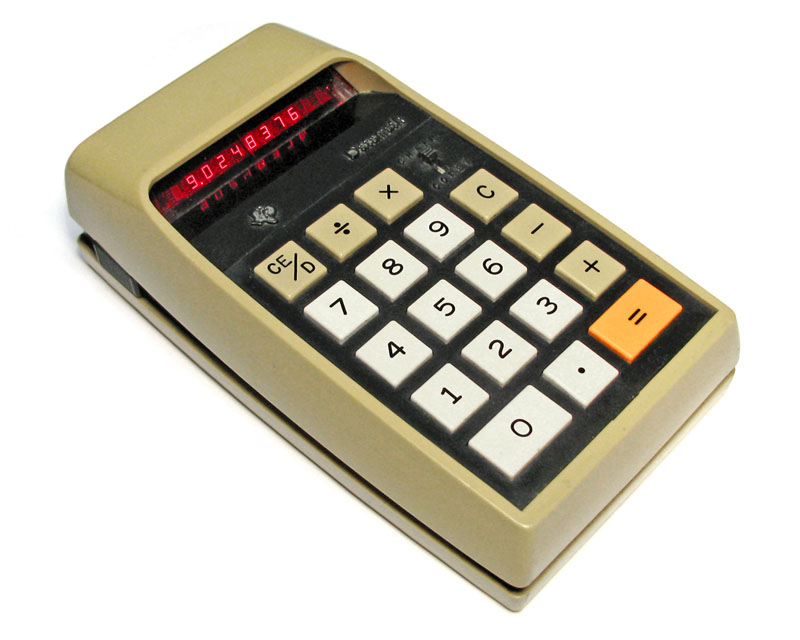
Posted on 10/24/2019 7:07:53 PM PDT by DoodleBob
The 12c calculator from Hewlett-Packard is one of those products that is so ubiquitous and familiar that you almost forget it exists, yet at the same time is so different that there's almost nothing like it. Whenever someone pulls it out of a drawer or pocket to do a calculation, no matter how trivial, you know you are dealing with a professional. Remarkably, it has been in continuous production for over 35 years, with very few changes. While there are now fancier and in some ways more sophisticated calculators, such as with screens for doing graphs, the 12c remains a cult status symbol for professionals.
And people really bond with their 12c's. I'm reminded of the chant from the movie Full Metal Jacket, when the recruits are first learning to use their rifles:
“This is my rifle. There are many like it but this one is mine. My rifle is my best friend. It is my life. I must master it as I must master my life. Without me, my rifle is useless. Without my rifle I am useless.”
The 12c has much the same aura: They are mass-manufactured, yet individual. Learning to use it well involves a pretty steep curve, and, like a sophisticated piece of software, the learning curve keeps going as you get better, egging you on to dive deeper, deeper. For accountants and other financial professionals who need to go beyond basic adding and subtracting, there's a host of sophisticated functionality. Amortization? Yes. Compound interest? Certainly. Calculating Net Present Value and Bond yields? Of course.
Toda the 12c can be bought for under $50. But when it was launched on September 1, 1981, it retailed for $150 (equivalent to over $400 today). Even at that price it was an instant success.
(Excerpt) Read more at massmadesoul.com ...
Why not buy one of these? Other available, too.
I used a cheap vinyl case casio through college also. It was just plain easy to use. Did all that I needed. I did pick up a HP 48 sx? My last year. It took longer to read the manual, than it did to just learn the subject matter.
I still use my Hewlett Packard Business Consultant II, 19B.
I also still use my Sharp ZR-5000 Zaurus.
I am not suggesting this is something anyone else should do.
I still use my Olympus Digital Voice Recorder VN-960PC.
Mine is sitting on the kitchen table next to me right now. I bought it about 25 years ago. Still works great.
interesting
Curta?
My older brother bought one of those in Lichtenstein from the King. I played around with it a little, but never spent enough time at his house to learn how to use it. Turn the crank & there is your answer.
Had not Bardeen and his Bell Telephone buddies invented solid state electronics, more of these might have been sold.
Mine is on my desk just about six inches from my left hand as I type this. I bought it in approximately 1982 since it was required for the CCIM class I had signed up for continuing education real estate license requirements. I have changed the batteries maybe three times. I never trusted real estate DCF software and have done all my calculations on my HP. It’s now real funky with a stickiness on the top and two edges of the metal plate on the back are coming up. If it was a guitar, it would be described as a “player”. I tend to lose it about every three to four years but after a day or so it turns up. Usually in a cranny in my bag or on the floor of my car. Or under piles of documents on my desk.
I thought as you did until I became aware of the manner in which the advanced math teachers instruct the students every day in class. They “teach to” the TI product (TI n-spire CX or TI n-spire CX CAS) that every student possesses and has possessed for decades now. A student whose parent bucks the trend and bought them an HP calculator (with an entirely different keyboard, different menu system, different functional breakouts, and of course a legacy of supporting Reverse Polish Notation that TI has never troubled itself with) quickly finds himself or herself at a distinct disadvantage. The instructional methods and study materials used by more or less every advanced math teacher in this country are so completely married to the specific functional breakouts, dropdown menus and overall logic that are unique and particular to the top-of-the-line TI calculators mentioned above, that they have effectively enshrined them in the class curriculum and handed near total monopoly market control over to Texas Instruments. Hewlett Packard’s RPN-supporting top-of-the-line calculators, fine and magnificent though they may be, occupy the ghetto of the high school and college/university advanced math market. HP’s overall market share in high-end personal calculators compared to TI’s is now an embarrassment. Unbelievably puny.
Never had a 12c but wanted a 21 that I could never afford. I managed through grad school with a TI.
I ended up with a small stack of 41cx and TI50A all complete with card readers, tape drives, docking stations etc. carefully stored away for some reason. One 41cx with my name etched into the case is within easy reach as it has been since 1985. Still works just fine. A real testament to great engineering and manufacturing. Built to last.

If it’s dependent on a specific calculator, then they’re not really teaching math. Some sort of perverted trade-school version of math that focuses on a rote process rather than the underlying principles and reasons. If they were teaching real math, you could do the work with a slate and chalk. People that ignorant, apathetic, or perhaps even malicious should never be teaching anyone anything, ever.
And this is supposedly the advanced class??? [seethes with rage] I missed that before posting my previous comment. x10 to everything I said in that post. Un-freakin-believable. Disgusting.
When I bought mine, I gave an extra $20 for a model that had complex arithmetic capability. I had $20 worth of fun just reading the instruction book.
Top shelf teacher, excellent results borne out by nearly every CalcAB and every CalcCD student scoring a “5” on the AP test. The students really do master the material. So the problem is really a narrow one. Our local school district’s high school math administrator and the high school math teachers have simplified things for themselves, not that they will admit it. No teacher will take a single step to encourage the use of Reverse Polish Notation. They will NOT tell you that you and your student will sorely regret buying a high-end HP calculator (for about $145). But your kid WILL pay the price, almost as if being taught in German and having to translate everything on the fly into French (and suffering the attendant exhaustion). And though you may wish to continue to “fight the power” you WILL end up putting the HP in a drawer, knuckling under, and heading out on a lonely Sunday night in October to buy a TI n-spire CX or a TI n-spire CX CAS calculator for $160.00, only to find that nobody has any in stock (sold out).

I distinctly remember my dad bringing this one home from work c.1972, and my being endlessly amazed at the idea of this little machine doing my homework. Google says the retail price was about $119; I'm surprised he let us take it to our friends' house because the inflated price is equal to about $750.
I was in the mortgage business. That calculator was mandatory. Everybody has one.
7734
Collected a few slide rules here, relearning them. Last time I used one was back in high school, 50+ years ago. Yes, there is an elegance about them. And most of the time, past the first three digits nobody cares.
We went to the moon with them. Literally. “Backup Computer” in the Apollos was a Pickett 600-T.
Also have a 41CX, thirty-plus years old, still works fine. Ran air-to-air intercepts with them in a past life. That was fun.
Disclaimer: Opinions posted on Free Republic are those of the individual posters and do not necessarily represent the opinion of Free Republic or its management. All materials posted herein are protected by copyright law and the exemption for fair use of copyrighted works.